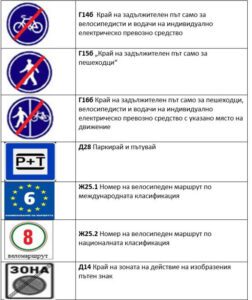
Sofia, Bulgaria: In a significant move to enhance road safety and streamline traffic management, Bulgarian authorities have introduced six new road signs, ushering in a wave of changes impacting cyclists and drivers of individual electric vehicles.
The alterations are detailed in the recently approved Ordinance on road signalling with traffic signs, a collaborative effort by the Minister of Regional Development and Public Works, the Minister of Transport and Communications, and the Minister of the Interior.
The Group “D” category introduces three new signs—G14b (Г14б), G15b (Г15б), and G16b (Г16б)—all indicating the end of mandatory roads for cyclists, pedestrians, and a combination of both, respectively.
These signs, G14b, G15b, and G16b, mark the conclusion of the corresponding mandatory paths for cyclists (G14a), pedestrians (G15a), and a shared path for pedestrians and cyclists (G16a).

This thoughtful categorization aims to bring clarity to road users and ensure compliance with designated pathways.
Within Group “D,” the introduction of a new sign, D28 (Д28) – “Park and travel,” is set to revolutionize parking facilities.
This sign will signal areas where commuters can park and seamlessly transition from regular passenger transport lines to public transport.
Additionally, the visual representation of road sign D14 (Д14) is expected to transform, aligning with the evolving standards outlined in the Ordinance.
Group G welcomes two new signs for cyclists—G25.1 (Ж25.1) and G25.2 (Ж25.2)—designed to facilitate cycling routes. These signs will display the international and national classification numbers of cycling routes, fostering cycling and alternative tourism.
The move reflects Bulgaria’s commitment to promoting eco-friendly transportation and encouraging recreational cycling.
Addressing the rise of individual electric vehicles, the Ordinance includes sign A20, signalling road sections where cyclists and electric vehicle drivers intersect with traffic lanes.
Simultaneously, the introduction of sign B9 (Б9) – “Prohibited for cyclists” in areas with dedicated lanes for cyclists and electric vehicle drivers emphasizes the need for adherence to designated lanes, enhancing overall safety.
One of the pivotal aspects of the Ordinance is the establishment of a new standard for chromaticity and brightness coefficients during the day and retroreflection at night.
This standardization is poised to bolster traffic safety significantly, ensuring optimal visibility of road signs across different lighting conditions.
By incorporating these measures, Bulgaria aims to elevate the road signalling quality and prioritize all road users’ safety and security.
A noteworthy element of the regulatory act is the provision for a competitive environment among manufacturers of road signs.
This move fosters innovation and ensures that the latest technological advancements are harnessed to enhance the efficiency and effectiveness of road signalling.
The Ordinance is scheduled to come into effect eight months after its promulgation in the State Gazette, allowing stakeholders adequate time for preparation and implementation.
This phased approach underscores the meticulous planning behind the regulatory changes, ensuring a smooth transition and minimal disruption to road users.
In a forward-looking approach, the Ordinance also addresses using and visualizing electronic signs with changing messages on roads throughout the country.
The introduction of five electronic signs, each tailored to the permitted maximum speed of the road, reflects Bulgaria’s commitment to embracing technological advancements for improved traffic management.
As nations worldwide grapple with evolving transportation dynamics, Bulgaria’s proactive stance in revamping road signs and regulations stands out as a beacon of progress.
The concerted effort to prioritize safety, streamline traffic flow, and accommodate emerging trends in transportation paints a promising picture for the future of Bulgaria’s road infrastructure.
The nation’s commitment to fostering a competitive market for road sign manufacturers further cements its dedication to ensuring the highest road safety and management standards.
This article was created using automation technology and was thoroughly edited and fact-checked by one of our editorial staff members
